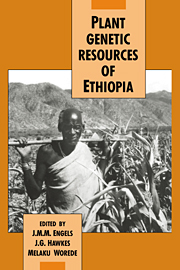Book contents
- Frontmatter
- Contents
- Contributors
- List of acronyms
- Preface
- Part I General introduction
- Part II The Ethiopian centre of diversity
- Part III Germplasm collection and conservation in Ethiopia
- 13 Theory and practice of collecting germplasm in a centre of diversity
- 14 A decade of germplasm exploration and collecting activities by the Plant Genetic Resources Centre/Ethiopia
- 15 Collection of Ethiopian forage germplasm at the International Livestock Centre for Africa
- 16 Germplasm conservation at PGRC/E
- 17 Documentation at PGRC/E
- Part IV Evaluation and utilization of Ethiopian genetic resources
- Index
15 - Collection of Ethiopian forage germplasm at the International Livestock Centre for Africa
Published online by Cambridge University Press: 30 October 2009
- Frontmatter
- Contents
- Contributors
- List of acronyms
- Preface
- Part I General introduction
- Part II The Ethiopian centre of diversity
- Part III Germplasm collection and conservation in Ethiopia
- 13 Theory and practice of collecting germplasm in a centre of diversity
- 14 A decade of germplasm exploration and collecting activities by the Plant Genetic Resources Centre/Ethiopia
- 15 Collection of Ethiopian forage germplasm at the International Livestock Centre for Africa
- 16 Germplasm conservation at PGRC/E
- 17 Documentation at PGRC/E
- Part IV Evaluation and utilization of Ethiopian genetic resources
- Index
Summary
Introduction
Ethiopia is an area rich in germplasm of many plant species and was considered as a primary centre of crop diversity by Vavilov (1951). Among the most important plant genetic resources of the East African region, and indeed of all of Africa, are forages and especially forage grasses (Zeven & Zhukovsky, 1975). Large areas of Africa are covered with tropical savannah with a great diversity of grasses which are vigorous and polymorphic (Clayton, 1983). Tropical forage legumes and browse species are also endemic. In particular, Africa has been described as the centre of diversity of the browse shrubs of the subfamily Caesalpinioideae (Williams, 1983).
The genetic resources of forages are usually found in wild populations since they have only been cultivated on a commercial scale for about 50 years and no landraces are available (Williams, 1983). This is very different from crop species and therefore the collection strategies for forages differ to accommodate the population structures found in the wild. Marshall & Brown (1983) have defined the objective of forage plant exploration as the collection of material with the maximum amount of useful genetic variability within a strictly limited number of samples. The strategy of the International Livestock Centre for Africa (ILCA) is to collect representative population samples from the wild, although in some cases only a few plants can be found growing together as a population and sampling is therefore limited (Lazier, 1984).
- Type
- Chapter
- Information
- Plant Genetic Resources of Ethiopia , pp. 218 - 225Publisher: Cambridge University PressPrint publication year: 1991
- 2
- Cited by



